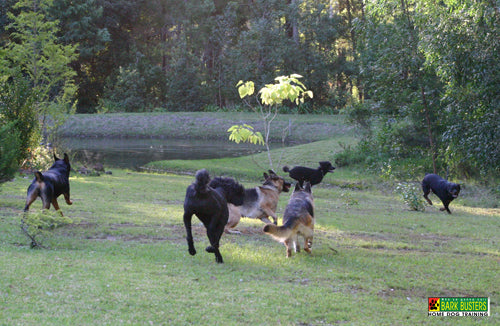Dog Parks - Safety Tips

Dog parks are an excellent way to get out some of that "extra" energy your dog may have. Dog parks can also be a great way to socialize your dog -- but can also be unsafe if proper measures aren't taken. The following tips are to help you keep your dog safe and happy at the park.
Know your dog. Not all dogs enjoy meeting new dogs. There are three types of dogs that shouldn't be at a dog parks.
- The adult dog that has not been previously socialized. Socialization is important for all dogs. For these dogs it may be better to begin the socialization process in a smaller setting.
- The dogs that plays too rough. Not all dogs like to be rolled, pinned or knocked over. If your dog plays rough match him with dogs that can tolerate rough play.
- The overly shy/timid dog. These dogs typically don't have fun at the dog park.
Don't let your dog get overwhelmed by meeting too many dogs at once. If your dog has not interacted regularly with other dogs, find out how he will react. You can perform a test by introducing your dog to a friends' dog that you know interacts well with other dogs. Testing your dog in a controlled environment is ideal before you go into the dog park.
Keep your dog healthy. Be sure your dog isn't vulnerable to picking up infections from other dogs by keeping him up to date on his vaccinations and worming medications.
Observe. Consider visiting the park without your dog for the first time to familiarize yourself with the park itself and the dogs that play there. Before bringing your dog inside the park, spend a few minutes watching the other dogs and how they interact. On your next visit you may want to bring your dog and sit quietly with him outside the park. Having your dog with you to observe from outside the park enables you to watch how he reacts to seeing the other dogs.
Start out slow. The first few visits to the dog park should be short, no longer than 15 minutes. Slowly increase the length of your stays as your dog becomes more comfortable with the dog park atmosphere.
Choose a time that is less busy for your first few visits to the park. Weekday evenings are peak, high-traffic times at dog parks, and weekends and holidays tend to be busy all day long. Acquaint your dog with the dog park when the park isn't as crowded.
Closely supervise your dog. Don't get distracted while talking to other owners. Keep an eye on your dog at all times to make sure his interactions with other dogs are safe. Watch his body language to help you avoid any trouble before it begins. Watching his actions also enables you to quickly clean up after your pet.
Let your dog off lead as soon as you enter unleashed areas. Mixing leashed and unleashed dogs can create a hostile situation. Leashed dogs, and their owners, often display body language and behavior that is threatening to the unleashed dogs and may encourage them to be aggressive and defensive in return. A leashed dog cannot make the choice his natural instinct tells him of "fight or flight" -- if he cannot take flight, he may have to fight.
Potential hazards. Be aware of potential hazards that may be in the park, such as toxic chemicals, garbage or noxious plants. Be sure to wash any chemicals, such as fertilizer or pesticides, off of your dog's feet and legs to ensure they aren't licked and ingested.
Leave children at home. Don't bring children with you to the dog park. You will not safely be able to watch your kids and your dog at the same time. Many dogs have not been socialized to children. Both frighten and excite easily -- and react differently -- creating a dangerous atmosphere. It's simply too easy for a child to get hurt at a dog park.
Leave small puppies at home. Puppies less than four months old aren't fully immunized yet and are at higher risk for contracting diseases. They are also very vulnerable to being traumatized by another dog's aggressive behavior.
Do not bring toys or food. Most parks are already littered with balls and toys that other people have brought. Rewarding your dog with treats or giving him toys in front of other dogs can create jealousy and aggression.
Body language. Educate yourself about dog body language and communication signals so you can tell the difference between fear, play and anger.
Know when to leave. You should remove your dog from the park if he is being threatened or bullied and seems fearful; begins to display aggressive behavior by becoming overexcited or threatening toward other dogs; is panting heavily; or seems overly tired. Keep your dog's welfare a top priority.
DO NOT physically intervene in a dog fight. Never reach in to break up fighting dogs. Squirt the dogs in the face with a water bottle or try to distract them by throwing something near them, but never physically intervene.
Prevent injuries. Be aware of the signs of a possible dog fight before it might happen. Don't allow a dog's over-excitement turn into a fight. If your dog injures a person or dog, give your name and phone number to the injured party. Report to council rangers any handlers who refuse to take liability for damages or injuries and who are endangering the safety of others.



